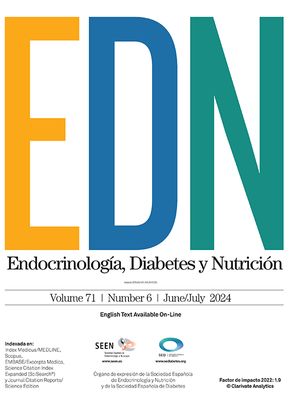Hypoglycemia, defined as plasma glucose levels <70mg/dL, is a potentially serious complication occurring in 40% of patients with type 1 diabetes mellitus, and less commonly in patients with type 2 diabetes mellitus.1 Different changes in the electrocardiogram (ECG) associated with hypoglycemia have been reported.
The case of a female patient referred to the emergency room of our hospital for loss of consciousness is reported below. This was a 74-year-old woman with long-standing diabetes on treatment with metformin 850mg/12h and Lantus® insulin 30IU at dinner. She was also being treated with pravastatin 10mg and Eutirox® 50μg for dyslipidemia and hypothyroidism respectively. At admission, the patient was unconscious, with no response to verbal or painful stimuli and mydriatic, nonreactive pupils. She was breathing spontaneously. Her blood pressure was 110/75mmHg, and heart rate 56bpm. Heart auscultation revealed cardiac rhythmic sounds, with no murmurs, and pulmonary auscultation found no pathological sounds. The initial capillary blood glucose level was 35mg/dL. Intravenous infusion of hypertonic glucose resulted in the recovery of consciousness and increased the blood glucose level to 280mg/dL. Laboratory test results included: chemistry: urea, 49mg/dL; creatinine, 1.2mg/dL; sodium, 141mEq/L; potassium, 3.9mEq/L; chloride, 112mEq/L; troponin Ic (peak value), 2.1μg/dL; baseline arterial blood gases: pH 7.42, pCO2 35mmHg, pO2 75mmHg, HCO3 22mmol/L; complete blood count: WBCs, 8760/μL; hemoglobin, 11.8g/dL; and platelets, 316,000/μL. The ECG at admission (Fig. 1) showed sinus rhythm at 62bpm with signs of left ventricular hypertrophy, 1mm ST segment elevation in aVR, and 1mm ST segment depression in II, III, aVF, and V4–6 with generalized asymmetrical negative T waves, and a QTc interval of 510ms. The ECG performed after the correction of hypoglycemia with intravenous hypertonic glucose (Fig. 2) showed a normalization of changes in the ST segment and repolarization, and the persistence of left ventricular hypertrophy (a pattern of diastolic overload with asymmetrical negative T wave in I, aVL, and V5–6). While the patient reported no chest pain, the slightly elevated troponin Ic level prompted the performing of an echocardiogram which showed moderate concentric hypertrophy and normal LVEF, and a treadmill exercise test which was electrically and clinically negative. The course of the patient in the ward was favorable, with good blood glucose control. She was discharged on Lantus® insulin 46IU at lunch time, and a rescue regimen of rapid-acting insulin based on the blood glucose level (less than 80mg/dL: none; 81–130mg/dL: 4IU; 131–200mg/dL: 7IU; 201–250mg/dL: 8IU; 251–300mg/dL: 10IUI; over 300mg/dL: 14IU), with the discontinuation of metformin.
Various electrocardiographic changes associated with hypoglycemia have been reported. Their incidence is unknown, as most data found in the literature come from isolated case reports. ST segment and repolarization changes, T-wave flattening and inversion, QT interval prolongation, as well as sinus tachycardia and bradycardia, various degrees of atrioventricular block, atrial fibrillation or supraventricular or ventricular extrasystole,2 and even the induction of fatal arrhythmia have been seen.3 The mechanisms of the electrocardiographic changes associated with hypoglycemia have not been fully elucidated. However, the direct effect of hypoglycemia, increased epinephrine secretion, secondary hypokalemia, and autonomic dysfunction have been suggested.4 Glucose is vital for myocardial metabolism, and hypoglycemia may be associated with deficient energy provision to the cell. On the other hand, secondary sympathoadrenal discharge increases oxygen consumption, and may also decrease the oxygen supply by vasoconstriction. All these factors may cause a significant impairment in cell metabolism The decrease in serum potassium levels that may occur with hypoglycemia could explain the changes in the ST segment, T wave, and QT interval,3 favored by excess circulating epinephrine levels.5 In an experimental study reported in 1975, Libby et al. stated that in hypoglycemia, ST depression occurred in territories without coronary artery disease, while elevation occurred in those supplied by obstructed coronary arteries.6 Maroto et al., however, reported the case of a young patient with ST segment elevation concurrent with hypoglycemia and with normal coronary arteries, and suggested that these changes resulted from a maximum degree of diastolic depolarization of cardiac myofibril caused by changes in intracellular potassium concentrations.7
It may be concluded that in any patient with diabetes who experiences ECG, hypoglycemia should be suspected as a cause.
Please cite this article as: Fernández Anguita MJ, Martínez Mateo V, Cejudo del Campo Díaz L, Villanueva Terrazas MÁ, Paule Sánchez AJ. Alteraciones electrocardiográficas transitorias durante un episodio de hipoglucemia. Endocrinol Nutr. 2016;63:96–97.








